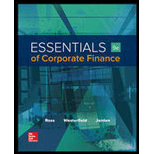
Concept explainers
S&S Air Goes International
Mark Sexton and Todd Story, the owners of S&S Air, have been in discussions with an aircraft dealer in Europe about selling the company’s Eagle airplane. The Eagle sells for $98,000 and has a variable cost of $81,000 per airplane. Amalie Diefenbaker, the dealer, wants to add the Eagle to her current retail line. Amalie has told Mark and Todd that she feels she will be able to sell 15 airplanes per month in Europe. All sales will be made in euros, and Amalie will pay the company €75,384 for each plane. Amalie proposes that she order 15 aircraft today for the first month’s sales. She will pay for all 15 aircraft in 90 days. This order and payment schedule will continue each month.
Mark and Todd are confident they can handle the extra volume with their existing facilities, but they are unsure about the potential financial risks of selling their aircraft in Europe. In their discussion with Amalie, they found out that the current exchange rate is $1.30/€. This means that they can convert the €75,384 per airplane paid by Amalie to $98,000. Thus, the profit on the international sales is the same as the profit on dollar-denominated sales.
Mark and Todd decided to ask Chris Guthrie, their financial analyst, to prepare an analysis of the proposed international sales. Specifically, they ask Chris to answer the following questions.
3. Ignoring taxes, what are S&S Air’s projected gains or losses from this proposed arrangement at the current exchange rate of $1.30/€? What happens to profits if the exchange rate changes to $1.37/€? At what exchange rate will the company break even?
Want to see the full answer?
Check out a sample textbook solution
Chapter 18 Solutions
ESSENTIALS CORPORATE FINANCE + CNCT A.
- Could you please help to explain the DMAIC phases and how a researcher would use them to conduct a consulting project? What is a measure process performance and how to analyze the process? What is an improve process performance and how the control improves process and future process performance?arrow_forwardConsider the two stocks below. Graph the frontier of combinations of the two stocks. Show the effect on the frontier of varying the correlation from −1 to +1. 1 2 3 Mean A B C D TWO STOCKS Varying the correlation coefficient Stock A Stock B 3.00% 8.00% 4 Sigma 15.00% 22.00% 5 Correlation 0.3000 Farrow_forwardLindsay is 30 years old and has a new job in web development. She wants to make sure that she is financially sound by the age of 55, so she plans to invest the same amount into a retirement account at the end of every year for the next 25 years. (a) Construct a data table in Excel that will show Lindsay the balance of her retirement account for various levels of annual investment and return. If Lindsay invests $10,000 at return of 6%, what would be the balance at the end of the 25th year? Note that because Lindsay invests at the end of the year, there is no interest earned on the contribution for the year in which she contributes. Round your answer to a whole dollar amount. $ (b) Develop a two-way table for annual investment amounts of $5,000 to $20,000 in increments of $1,000 and for returns of 0% to 12% in increments of 1%. From the 2-way table, what are the minimum annual investments Lindsay must contribute for annual rates ranging from 6% to 11%, if she wants to…arrow_forward
- Does Airbnb have any impaired assets? If so, what are they?arrow_forward1. Consider two assets with the following returns: State Prob. of state R1 R2 1 2/3 .03 .05 2 1/3 .09 .02arrow_forwardBright wood! Seating sells reclining chairs for $55.00 per unit. The variable cost is 322 per unit. Each reclining chair requires 5 direct labor hours and 3 machine hours to produce. ibution margin pemachine hon Wrightwood Manufacturing has a break-even point of 1,500 units. The sales price per unit is $18. and the variable cost per us $13. If the company sells 3,500 units, what will its net income be? Crestwood Industries provides the following budget data for its Processing Department for the year 2022: ⚫ Manufacturing Overhead Costs=250 ⚫ Direct Labor Costs $1,234,500 Determine the manufacturing overhead application rate under the base of Direct Labor Costs. Modesto Accessories manufactures two types of wallets leather and canvas. The company allocates manufacturing overhead using a single plant wide rate with direct labor cost as the allocation base. $48 Estimated Overhead Costs = 30,600 Direct Labor Cost per Leather Wallet Direct Labor Cost per Canvas Wallet = $52 Number of…arrow_forward
 Cornerstones of Cost Management (Cornerstones Ser...AccountingISBN:9781305970663Author:Don R. Hansen, Maryanne M. MowenPublisher:Cengage LearningPrinciples of Accounting Volume 2AccountingISBN:9781947172609Author:OpenStaxPublisher:OpenStax College
Cornerstones of Cost Management (Cornerstones Ser...AccountingISBN:9781305970663Author:Don R. Hansen, Maryanne M. MowenPublisher:Cengage LearningPrinciples of Accounting Volume 2AccountingISBN:9781947172609Author:OpenStaxPublisher:OpenStax College

